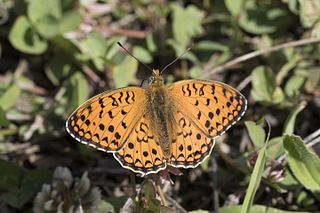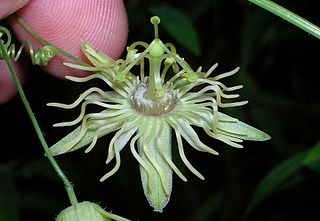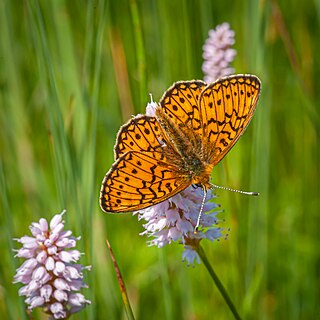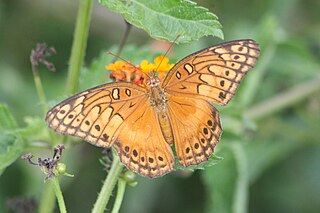
Passiflora incarnata, commonly known as maypop, purple passionflower, true passionflower, wild apricot, and wild passion vine, is a fast-growing perennial vine with climbing or trailing stems. A member of the passionflower genus Passiflora, the maypop has large, intricate flowers with prominent styles and stamens. One of the hardiest species of passionflower, it is both found as a wildflower in the southern United States and in cultivation for its fruit and striking bluish purple blooms.

The dark green fritillary is a species of butterfly in the family Nymphalidae. The insect has a wide range in the Palearctic realm - Europe, Morocco, Iran, Siberia, Central Asia, China, Korea, and Japan.

The Niobe fritillary is a species of butterfly in the family Nymphalidae.

The Queen of Spain fritillary is a butterfly of the family Nymphalidae.

The great spangled fritillary is a North American butterfly of the family Nymphalidae.

Passiflora lutea, commonly known as yellow passionflower, is a flowering perennial vine in the family Passifloraceae, native to the central and eastern United States. The vine has three-lobed leaves and small, yellowish-green, fringed flowers that appear in the summer, followed by green fruit that turn almost black at maturity. It grows in moist to wet habitats.

Boloria dia, the Weaver's fritillary or violet fritillary, is a butterfly in the family Nymphalidae. The name Weaver's fritillary is in honor of Richard Weaver, an English insect collector who claimed to have obtained the specimen within ten miles of Birmingham around 1820. However, B. dia is very rare in England and the few specimens known from there are thought to be from possibly accidental introductions.

Boloria eunomia, the bog fritillary or ocellate bog fritillary is a butterfly of the family Nymphalidae.

Boloria titania, the Titania's fritillary or purple bog fritillary, is a butterfly of the subfamily Heliconiinae of the family Nymphalidae.

Boloria bellona, the meadow fritillary, is a North American butterfly in the brushfoot family, Nymphalidae. The common name, meadow fritillary, is also used for a European butterfly species, Melitaea parthenoides.

Nathalis iole, the dainty sulphur or dwarf yellow, is a North American butterfly in the family Pieridae.

Euptoieta hegesia, the Mexican fritillary, is a North and South American butterfly in the family Nymphalidae.

Ancyloxypha numitor, the least skipper, is a North American butterfly in the family Hesperiidae. They have a weak, Satyrinae-like flight.

Danaus eresimus, the soldier or tropical queen, is a North American, Caribbean, and South American butterfly in the family Nymphalidae.

Eurema proterpia, the tailed orange, is a North and South American butterfly in the family Pieridae.

Chlosyne lacinia, the bordered patch or sunflower patch, is a North and South American butterfly in the family Nymphalidae.

Kricogonia lyside, the lyside sulphur or guayacan sulphur, is a North American, Caribbean, and South American butterfly in the family Pieridae.

Chlorostrymon simaethis, the silver-banded hairstreak, is a North and South American butterfly in the family Lycaenidae. It is also known as St. Christopher's hairstreak and the Key lime hairstreak.

Speyeria callippe, the callippe fritillary, is a North American species of butterflies in the brush-footed family Nymphalidae.


























